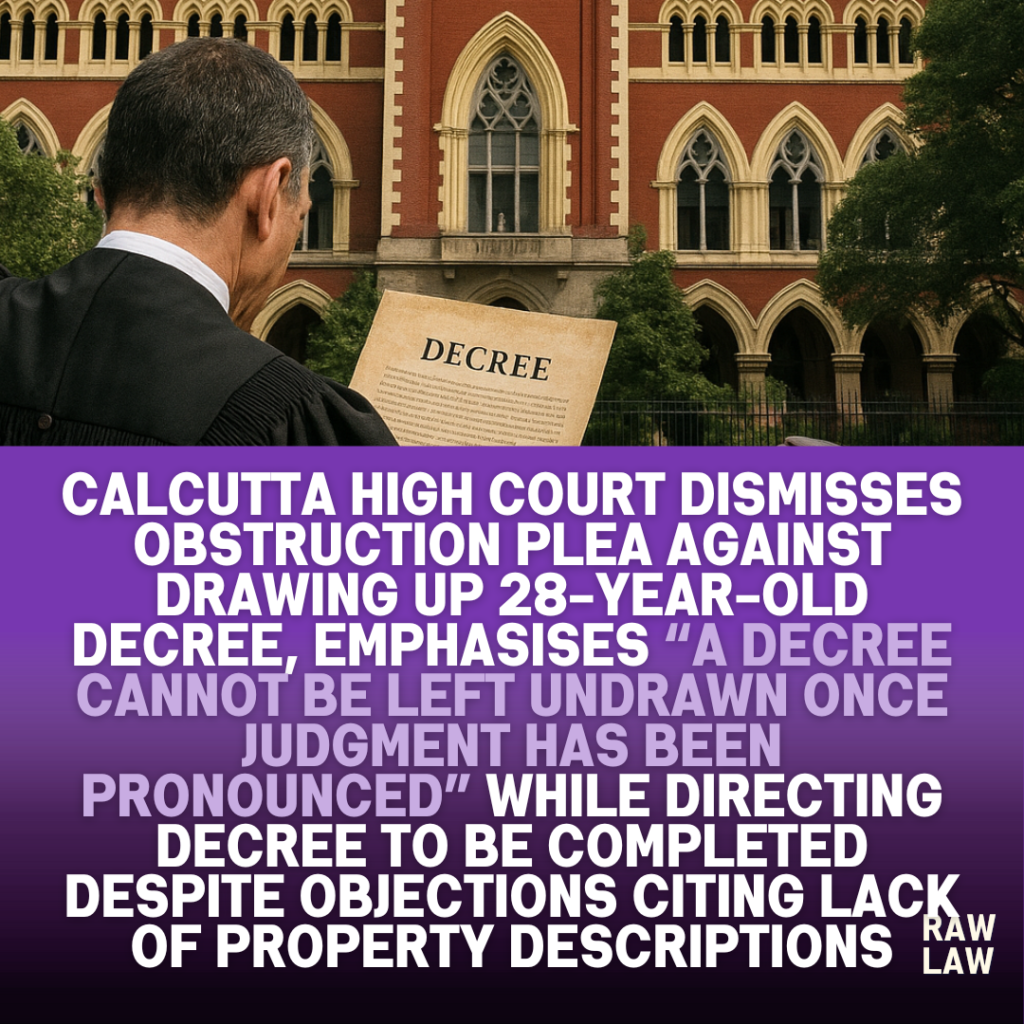Court’s Decision
The Calcutta High Court dismissed an application seeking to restrain the Learned Master from drawing up a decree in a matter pending since 1997, rejecting objections raised regarding the absence of property descriptions in the decree. The Court imposed costs of Rs. 25,000 to be paid to the West Bengal State Legal Services Authority within a fortnight and directed the Learned Master to draw up and complete the decree within two weeks, despite the petitioner’s objections that the decree could not be drawn without property details.
Facts
A decree was passed on 22 May 1997 in a partition-related appeal, but the decree remained undrawn for over 28 years due to disputes between the parties. The respondent no. 2 recently filed an application seeking to restrain the Learned Master from drawing up the decree, arguing that without a description of the concerned properties, the decree could not be finalised, and sought a recall of a previous order passed on 22 May 2025. Meanwhile, respondent no. 1 filed an application seeking immediate drawing up of the decree, alleging that respondent no. 2 was resisting completion with oblique motives, using the excuse of the absence of property descriptions.
Issues
- Whether the Learned Master should be restrained from drawing up the decree in the absence of specific property descriptions.
- Whether the decree could be completed despite objections regarding property descriptions raised after the pronouncement of judgment.
Petitioner’s Arguments
The petitioner argued that the decree could not be drawn up without including the property descriptions, relying on Order VII Rule 3 read with Order XX Rule 9 of the Code of Civil Procedure. The petitioner cited Nahar Singh vs. Harnak Singh (1996) 6 SCC 699, to contend that a decree for the recovery of immovable property cannot be completed without the details of such properties. It was contended that attempts to include property details through an application under Section 152 CPC had failed up to the Supreme Court, leaving the decree incomplete.
Respondent’s Arguments
The respondent argued that the judgment dated 22 May 1997 fulfilled the requirements of Order XX Rule 6 CPC and the Original Side Rules of the Calcutta High Court, which do not mandate detailed property descriptions if the operative parts of the judgment and the annexed documents sufficiently clarify the distribution of properties. It was contended that the repeated objections were tactics to prevent the decree’s completion, thereby depriving the decree-holder of the fruits of the judgment.
Analysis of the Law
The Court analysed the interplay of Order XX Rule 6 CPC and the Original Side Rules, reiterating that the operative portion of the judgment itself can be treated as the decree until a formal decree is drawn. It referred to the mandate under Rule 1 and Rule 11 of Chapter 16 of the Original Side Rules requiring the decree to be drawn up on judgment being pronounced, emphasising that short recitals may be added by the Master using pleadings and materials on record to finalise the decree.
Precedent Analysis
The Court relied on its previous judgment dated 3 April 2019, which held that the judgment dated 22 May 1997 clearly set out the reliefs granted and fulfilled the requirements for drawing up the decree, and clarified that the description of immovable properties could be drawn from the annexed Mittal Settlement and related orders. The case of Nahar Singh vs. Harnak Singh (1996) 6 SCC 699 was distinguished on facts, as the present matter involved a declaration and cancellation of a document with annexures detailing the properties.
Court’s Reasoning
The Court noted that the decree could not be left undrawn once judgment had been pronounced and that a party cannot be deprived of the fruits of a decree due to objections by another party. It held that the judgment dated 22 May 1997, together with the annexures, contained sufficient particulars to draw up the decree, and the objections raised were found to be motivated to delay proceedings.
Conclusion
The application to restrain the Learned Master from drawing up the decree was dismissed with costs of Rs. 25,000 to be paid to the West Bengal State Legal Services Authority within 15 days. The Learned Master was directed to draw up and complete the decree within a fortnight from the date of communication of the order, with liberty to place non-cooperation by any party before the Court.
Implications
- Reinforces that decrees must be drawn upon pronouncement of judgment, even if minor administrative objections are raised.
- Clarifies that detailed property descriptions may not always be necessary if operative orders and annexures sufficiently identify the subject properties.
- Emphasises that obstructive litigation tactics to delay decree execution will not be entertained by the courts.
Referred Cases and Their Application:
- Nahar Singh vs. Harnak Singh (1996) 6 SCC 699 – Cited by petitioner to argue that decrees without property descriptions are incomplete. Distinguished on facts as present case involved annexures describing properties.
- Calcutta High Court Order dated 3 April 2019 – Relied upon by the Court to confirm that the 1997 judgment fulfilled requirements for drawing the decree and that the operative parts with annexures suffice to proceed.
FAQs
1. Can a decree be drawn without detailed property descriptions?
Yes, if the judgment and annexed documents sufficiently identify the properties, the decree can be drawn, as reiterated by the Calcutta High Court.
2. What happens if one party obstructs the drawing up of a decree?
The court can impose costs and direct the decree to be drawn up, ensuring the decree-holder is not deprived of the judgment’s benefits due to obstruction.
3. Is a decree mandatory after the judgment is pronounced?
Yes, the decree must be drawn up after judgment, and the operative part of the judgment may be treated as the decree until formal drawing up is completed.
